CBSE Class 6 Science Notes Chapter 7 Getting to Know Plants
CBSE Class 6 Science Notes Chapter 7 Getting to Know Plants are given below. Our notes are designed by the subject experts and are as per the NCERT guidelines. These notes include all the important points of the chapter in detailed way, so you can refer to this whenever required. Study Path provides CBSE Class 6 Science Notes Chapter 7 that are easy to understand and also free downloadable PDF format, so students can practice it for their studies and get good marks in their examinations.
Getting to Know Plants Class 6 Notes Science Chapter 7
Introduction
As we all know, Earth is the only planet in our solar system that has the viable conditions for life to exist. While the presence of water and oxygen is the main reason, we must also recognize that life would not have been possible if it weren’t for the oxygen-emitting plants, life would not have been able to take shape on Earth. These plants are not only our source of oxygen but also the major source of the food that we eat.
Introduction to plants
Plants are all around us. They help sustain life on earth by creating food and giving out oxygen that we breathe in.
Plants
- Plants are the immovable living organisms all around us.
- They are the primary food providers.
- They are mostly green in colour and use sun as the source of energy to make food.
Herbs, shrubs and trees
We can classify plants on the basis of the thickness of their stems and the place of origin of their branches, into three broad categories:
- Herbs are the smallest plants and do not have woody stem.
- Shrubs are slightly larger than herbs.
- Trees are the largest plants and can have large and thick woody stem.
Herb: These are plants that have green and frail stems. Usually, these are small plants with not many branches.
Some common examples of herbs are Basil, Coriander, Mint, Oregano, Thyme, Parsley, Rosemary etc.
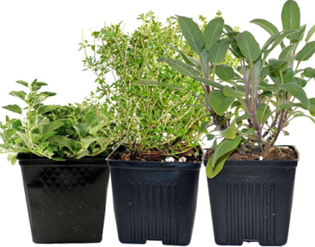
Shrubs: These are plants with hard but not exactly thick stems. Their branches generally originate from the base of their stems. These are much taller than herbs but usually shorter than trees.
Some common examples of shrubs are Aloe Vera, Rose plant, Jasmine plant, Blackberry plant etc.

Trees: These are plants which are very tall and have a thick and hard stem. The branches originate from the upper part of the tree and are very high above the ground.
Some common examples of trees are neem, peepal, coconut tree, mango tree etc.

Creepers and climbers
Creepers and Climbers are types of plants, which need support to grow.
Creepers: These are plants which have soft, weak and green stems and hence cannot stand straight and instead spread on the ground.
Some common examples are sweet potato, watermelon, pumpkin etc.
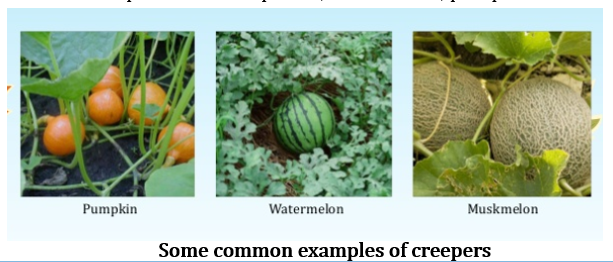
Climbers: These are also plants with soft and weak stems but instead of spreading on the ground they take support with a nearby object to climb up.
Some common examples of creepers are cucumber, bean, grapevine, money-plant etc.
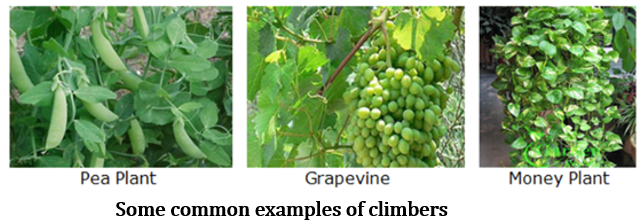
Some common examples of climbers
Algae and mosses
- Algae and mosses are the most primitive or simple plants.
- Algae are found mostly floating on water and mosses are seen on surfaces, rocks or bark of trees in humid conditions.
Leaf
The leaves of plants are majorly responsible for performing two essential functions for the plant’s survival and growth. These two functions are called transpiration and photosynthesis.
Different parts of a leaf
Leaf has different parts:
- the midrib
- the veins
- lamina
- Petiole
Petiole: This is the stalk via which the leaf is joined to the plant.
Lamina: This is the expanded part or the green portion of any leaf which is responsible for photosynthesis.
Veins: The many lines that run through the surface of the leaf are called veins and the design made by them is called leaf venation. They transport water and minerals.
Midrib: This is the central, prominent thick structure right in the middle of the leaf that helps support the leaf and prevent it from breaking.

We distinguish between two major types of leaf venation.
Reticulate venation is said to exist when the veins form a net-like shape on either side of the midrib. This type of venation is seen to exist in dicots like guava and mango.
Parallel venation is said to exist when the veins run parallel to one another. This type of venation is seen to exist in monocots like banana, wheat, coconut etc.
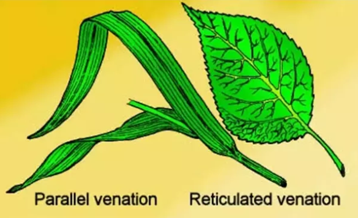
Transpiration
Transpiration is the loss of water from aerial parts of the plant, especially from leaves. Water is lost in the form of water vapours through tiny openings called stomata, present on the underside of leaves.
Photosynthesis
Photosynthesis is defined as the process that helps leaves prepare food for the plant with the help of carbon dioxide and water. Photosynthesis occurs in the presence of sun and is aided by the presence of a green pigment in leaves called chlorophyll. Plants also release oxygen in the process. The food prepared is stored in various parts of the plant. In absence of photosynthesis, the plant is unable to utilise the water and minerals to prepare food for its nourishment and gradually dies.
Root
Root is the part of the plant that is found under the soil. It provides stability to the plant and also absorbs water and minerals.
- Roots are responsible for absorbing minerals and water from the soil and transferring them to the stem. It’s only after root has transported water and minerals to stem that the stem becomes capable of transporting these to all parts of the plant.
- Another important function of roots is to firmly anchor the plant in the ground. This is essential to support the upright position of the plants.
- Roots also perform the function of storing important nutrients and food for growth.
Types of roots
There are two types of roots; tap root and fibrous root. Tap roots are seen in large trees and shrubs. Fibrous roots are common in herbs.
| Tap Roots | Fibrous Roots |
| 1. In this type of root system, there is one prominent and long root and a bunch of smaller roots that grow from this main root called lateral roots. | 1. In this type of root system, a group of similar sized roots emerge from the base of the plant. They do not have a main root. |
| 2. It is hard to pull out plants with tap roots as these go deep within the soil. | 2. These plants are relatively easier to pull out as the roots don’t go very deep in the soil. |
| 3. This root system is seen to exist in plants with leaves displaying reticulate venation. | 3. This root system is seen to exist in plants with leaves displaying parallel venation |
| 4. Examples of plants with tap roots: carrots, turnip, gram, gram, China rose etc. | 4. Examples of plants with fibrous roots: banana, wheat, maize, onion, bamboo etc. |

Stem
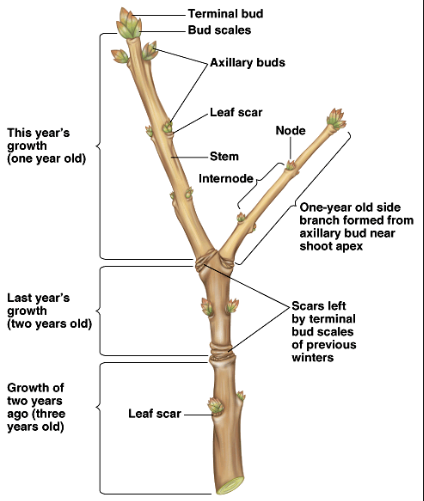
Growth cycle of a common stem
The Stem is the part of a plant which is responsible for supplying water to all parts of the plant. It is the stem which bears branches, flowers, leaves, fruits and buds. The root sucks the water and minerals from the soil and it is the stem’s function to push this water upward to other parts of the plant.
We can observe this by soaking the stem of a plant in a glass with water. On adding coloured ink to the water, we observe that after a while the stem and leaves of the plant start to turn the colour of the ink, which is proof that the stem carries the water to the different parts of the plant.
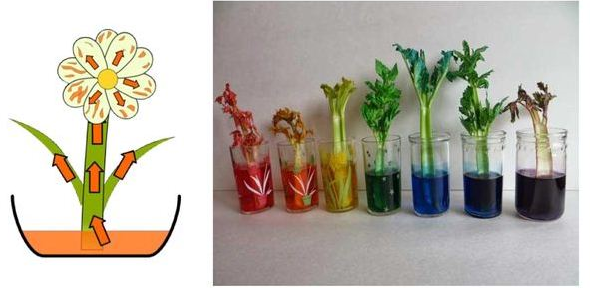
The experiment helps demonstrate how stems are responsible for carrying water to different plant parts
Flower
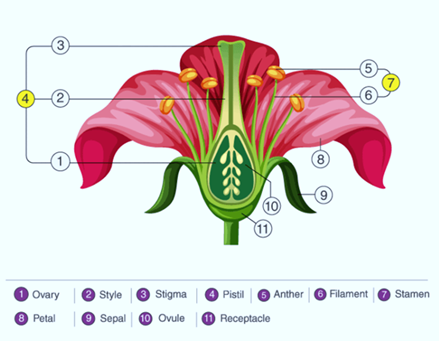
A flower is the reproductive part of a flowering plant. The only function a flower serves is the reproduction.
The flowers are the colourful, seed-bearing parts of the plant that grows at the end of the stem. A typical flower exhibits the following structure:
Petals: These are bright, colourful and broad parts of the flower. Taken together, the petals of the flower form what is called a Corolla.
Sepal: This is the green, leaf-like structure of the flower that encloses the petals and is responsible for protecting the flower when it is in its bud form and supporting it when it is in its bloom stage.
Stamen: These are the long and slender parts of the flower that become visible upon removing the petals and sepal of a flower. Typically, a stamen consists of an anther i.e. the head of the stamen and a filament i.e. the long cream-colored stick. The stamen is also known as the male reproductive part of the plant.
Pistil: This is the innermost part of the flower, typically consisting of a stigma i.e. the head of the pistil, a style, which is the long sticky part that attaches the stigma to the ovary i.e. the small and swollen sphere at the base of the pistil. Pistil is the female reproductive part of any flower. The ovary contains small bead-like structures which are called ovules.
Seed: A seed is an enclosed dormant embryo of a plant. They are found in the fruits and when sown, gives rise to a new plant.
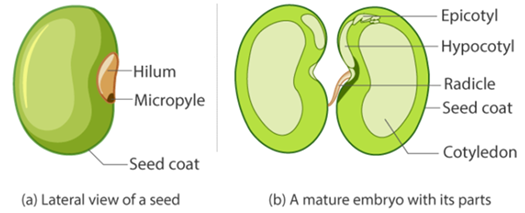
Parts of a seed
A seed is made up different parts. The plumule gives rise to the shoot and the radicle grows into the roots. The cotyledons provide nutrition.
Types of seeds
There are two types of seeds on the basis of number of cotyledons. Monocots have single cotyledon. Dicots have two cotyledons.
Important Definitions
Stomata: These are the small microscopic pores present on the leaf through which exchange of gases and transpiration takes place.
Annuals: These are plants like wheat and maize that complete their life cycle in one season and then die. They are usually herbs.
Biennials: These are plants like carrots and radishes that complete their life cycle in two seasons.
Perennials: These are plants guava and palm that continue their life cycle for more than two seasons, i.e. they manage to re-grow every spring.
Aerial roots: These are roots of plants and trees that grow above the ground instead of under the ground as shown in the image below.
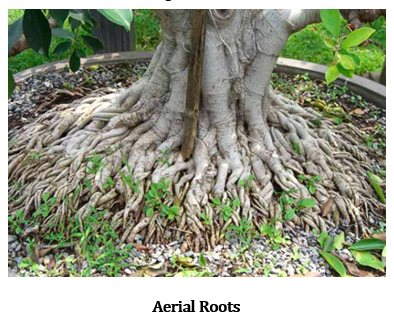
Revision Notes for CBSE Class 6 Science Chapter 7 – Free PDF Download
Our Class 6 Revision Notes will provide a quick glimpse of the chapter and improve the learning experience. We have made these revision notes keeping the convenience of students in mind so that it proves more effective. You can easily read these Class 6 notes just by clicking on the chapter names provided above.